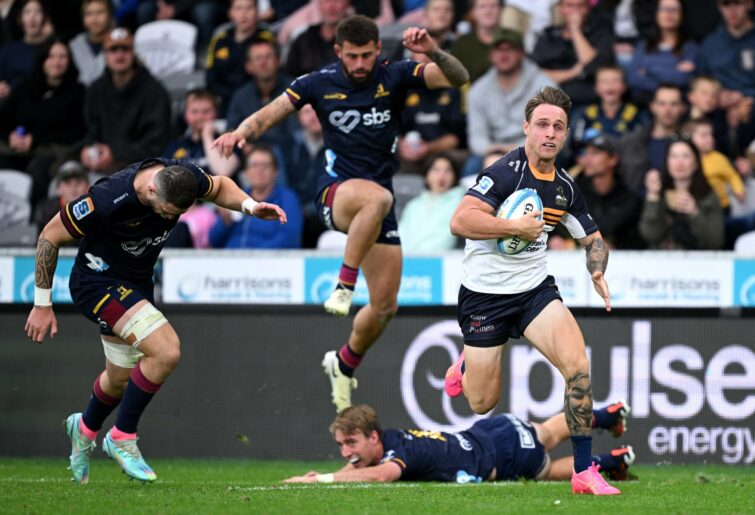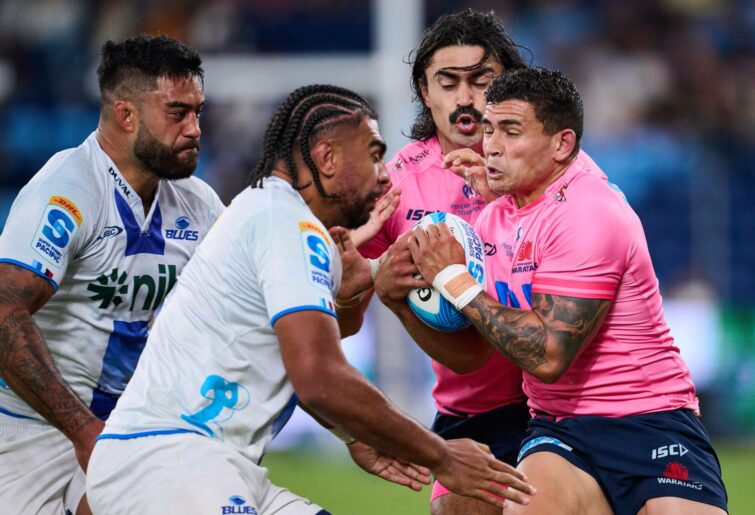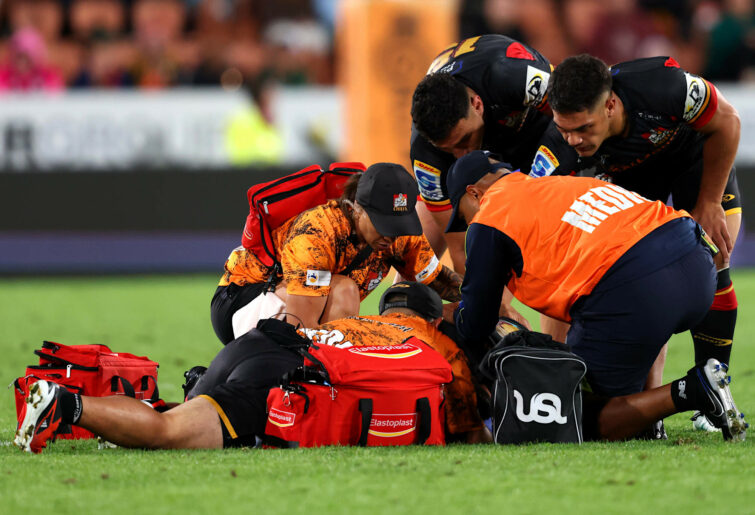Three losses became four as the Crusaders cemented their place on the lowest rung of the Super Rugby ladder, losing 14-10 to the table-topping Hurricanes, at home.
In truth, this was a gutsy effort, particularly on defence, by a short-manned team that suffered further during the week with the loss of skipper Scott Barrett. These are tough, unfamiliar times in Christchurch, but a win doesn’t feel too far away.
For much of the game, the Hurricanes were their own worst enemy – lineout and goalkicking well below par – but they narrowed their attack in the final quarter and, just like in Super Round, found a try to win at the death, to Justin Sangster.
With pedantic refereeing and over-involvement of the TMO a perennial flash point for fans, full credit is due to James Doleman and Chris Hart for the way they handled what at first glance, appeared to be a runaway try to Hurricanes’ halfback Cam Roigard.
By the time the conversion was being lined up, Hart had already confirmed that Roigard had touched the ball into his opposite Willi Heinz, before scooping it up and haring off. No big screen replays. No stopping the game. Right result on all counts.
Coming off their stunning win against the Chiefs, the Reds lit up Melbourne’s AAMI Stadium with an impressive display of high-speed, high-skill, running rugby. With first-half possession running at 70 per cent in favour of the Reds, the Rebels were powerless to slow down the Reds’ lightning quick recycle game; out of breath and out of the game, 33-7 at half-time.

(Photo by Robert Cianflone/Getty Images)
The Rebels recovered well after the break; the bench forwards providing more energy and accuracy in attack. But their brave claw-back to 38-26 was as good as it would get, with the Reds eventually cruising to a 53-26 win.
Confidence is a wonderful thing and right now, with their fast, short-passing game in full swing, the Reds are going as well as any team in the competition.
Their next opponent is the Western Force, whose coach Simon Cron rendered all additional commentary superfluous, providing a series of quotable quotes following his side’s 22-14 loss to Moana Pasifika.
“That’s some of the worst rugby I’ve seen”; “We went out to club rugby heroics”; and “Oh my god, we’ve got to coach that again?” were just some of the printable ones, with tradesmen no doubt due at HBF Stadium this morning to repair where paint was blistered off the walls of the Force changing room.
Disappointing losses aren’t always about the losing team, of course, and full credit goes to Moana Pasifika, who conjured a slick set-piece try to Kyren Taumoefolau, and who fully deserve their two wins so far; a number that already exceeds the expectations of most, for the whole season.
The Brumbies put a poor record in Dunedin behind them, as a strong second-half performance saw them through to a well-deserved 27-21 win against the Highlanders.
In what was a highly enjoyable, seesawing match, a superb solo try to captain Billy Harmon put the home side ahead in the final quarter. But from behind his own goal-line, Sam Gilbert opted for a flop wedge when the situation demanded driver; his meek kick setting the Brumbies up for their first line-out maul drive try since Round 11 last season.
The Dunedin match also provided this week’s coaching lesson, with the Highlanders’ Jacob Ratumaitavuki-Kneepkens seemingly the only person left in Super Rugby unaware that Brumbies’ winger Corey Toole has serious toe.

Corey Toole of the Brumbies charges towards the tryline (Photo by Joe Allison/Getty Images)
All coaches across the competition will have stressed to their outside backs the need to crowd and mark up on Toole more closely than they would other opponents. Yet here was Ratumaitavuki-Kneepkens drifting infield a couple of paces, to help Timoci Tavatavanawai out in a tackle he didn’t need any help making, in the process leaving separation between himself and the Brumbies winger.
Turn and chase Toole from behind? Pfft! Less chance of pulling that off than Rugby Australia coming clean about how much they have spent, and are spending, on propping up the Waratahs.
With crowds and value for spectators such a big issue in rugby, organisers in Hamilton got things right with a captivating drone Lord of the Rings light show at half-time of the match between the Chiefs and the Fijian Drua, won 46-29 by the home side.
Credit, also, to Sky NZ for pulling back on the mostly superfluous half-time chit chat, to let home viewers enjoy the show as well; hopefully in the process, enticing some of them to roll up in person next time.
The two sides also did their bit to add to the entertainment, giving the ball plenty of air in between the inevitable bone-crunching hits. File under ‘terrific fun’.
Less enjoyable was the Blues’ scrappy 12-10 win over the Waratahs in a dampish Sydney. While conditions weren’t perfect, they certainly weren’t sufficient reason for such a stop-start game, with lack of ambition and lack of skill seemingly in competition with each other to be major disruptor.

Izaia Perese of the Waratahs is tackled during the round four Super Rugby Pacific match between NSW Waratahs and Blues at Allianz Stadium, on March 16, 2024, in Sydney, Australia. (Photo by Brett Hemmings/Getty Images)
Referee Jordan Way had a sound match and is growing in confidence, but his decision to stifle a Blues scrum in the second half was a curious one. Yes, fans want to see the ball given air, and yes, halfback Finlay Christie should have cleared the ball when told to do so by Way.
But a referee’s job is to police the game, not to compel a team to play in a particular way. The Blues scrum was moving forward and, for as long as the laws provide for it, they have a right to play through their pack should they choose to do so; not be coached to take the ball out of a moving scrum.
In other news, Wallabies coach Joe Schmidt has confirmed a second addition to his coaching team, ex-Rebels assistant coach Eoin Toolan, to an analyst/skills role, joining Laurie Fisher on staff. Both are terrific appointments, and conclusive evidence that, at least where the Wallabies are concerned, the adults are back in charge.
A pivotal day looms on Tuesday where Rugby Australia officials, led by CEO Phil Waugh, will meet with directors of the Melbourne Rebels, to try to thrash out a path forward (or not) for the Rebels, and for the game in Australia.
This is a meeting that should have taken place in December where, in more cordial and constructive circumstances, a less damaging outcome might have been achievable.

Rugby Australia CEO Phil Waugh speaks to the media. (Photo by Chris Hyde/Getty Images)
Instead, with Rugby Australia choosing at the time to disengage, and the Rebels’ directors since resorting to legal measures to bring them to the table, the two parties have become adversaries.
Expect Simon Cron’s closed-door language to be positively saintly compared to some of the exchanges in Melbourne. That said, it is essential that both parties see out the shouting phase and work constructively towards a solution that provides a solution for creditors, and delivers much needed certainty for the Rebels’ staff and players.
Without it, and with player managers now actively working to disrupt and tear at the fabric of the current Rebels’ team, an already extremely tough situation is only going to get worse.
Finally this week, rugby’s concussion issue has taken centre stage again with confirmation of a diagnosis that ex-Hurricanes, Crusaders and Blues halfback Billy Guyton, who committed suicide at age 33, had chronic traumatic encephalopathy (CTE) at the time of his death.
This news will be no surprise to anyone who knew Guyton and spoke of his suffering debilitating effects of repeated concussions, and it once again highlights how far rugby has yet to travel to fully comprehend how it can ensure the safety of participants and future-proof the longevity of the sport.
In the meantime, rugby limps along with continued failures in process, such as an incident during the weekend’s Six Nations match between Wales and Italy, which saw two players, Lorenzo Pani and Mason Grady, allowed to stay on the field, without undergoing assessment, after a head clash.
Of the incident, Professor John Fairclough, of noted advocacy group Progressive Rugby, said: “The failure to remover either (player) following a clear and obvious high-speed clash of heads again calls into question the elite game’s desire to cement the welfare of its players as its No.1 priority.
“We ask again that we learn the lessons of the past and the default position to err on the side of caution to mitigate risk to short and long-term brain health,” he concluded.
This follows the incident during Super Round in Melbourne where Jordan Petaia was allowed to stay on the field for a period to continue playing, despite displaying obvious heavy concussion symptoms, following a direct hit to the head by Jordie Barrett.
In this regard, rugby continues to talk a good game, but too often fails players as a result of insufficiently robust observance and action processes.
In the meantime, an unhelpful debate rages on with respect to the efforts of some Southern Hemisphere nations to have their northern counterparts agree to adopt a 20-minute red card, for when players are sent from the field for serious misdemeanours, such as causing direct head contact.
As ever, when entrenched positions are adopted and defended, nuance is lost and the opportunity for rational, sensible decision making is impeded.
Proponents of the 20-minute card, in their haste to represent fans who don’t want to see matches ruined by 15 v 14 situations, should be more respectful of the genuinely held position that any new measure that might be seen to result in players not being sufficiently deterred from changing behaviour around tackling, so that the safety of all players is better enhanced, is a retrograde one.
Conversely, those staunch player safety advocates would be better served trying to understand how it might be possible to better differentiate between egregious reckless and dangerous acts of foul play, and accidental or incidental incidents, and to provide for the introduction of appropriate sanctions for each, without watering down genuine safety objectives.
In that respect, the current 20-minute red card debate is not quite the right one to be having. A better starting point might be to question how and to what extent, cards and suspensions actually change player behaviour and make the game safer?
Last weekend, Reds prop Sef Fa’agase became the latest player to fall foul of what has become little more than a lottery, copping a four-week suspension for a clash of heads with Chiefs player, Simon Parker.
It is hard to know what behaviour change Fa’agase – who was bent at the hips attempting to make a fair tackle on a player who was also dipping – will make as a result of his suspension, other than to avoid the collision zone altogether.
If that incident had occurred in the first minute of the match, and Fa’agase had received the red card that was subsequently determined by the judiciary, and his side been forced to play with 14 men for the whole match (under non-SANZAAR laws), this would have represented an outcome that, arguably, turns fans and coaches away from accepting sensible, necessary measures.
When it comes to actual player safety – as opposed to the optics of player safety – World Rugby’s continued insistence on the use of match officials and judiciaries as primary, blunt-instrument, agents of change, remains highly questionable.
There was also an interesting incident in the Hamilton match, where Chiefs centre Anton Lienert-Brown suffered a heavy concussion during the second half, after hitting his head heavily on the FMG Stadium turf.

(Photo by Michael Bradley/Getty Images)
Referee Dan Waenga sensibly stopped play as soon as he became aware of the injury, and Lienert-Brown was carefully treated on the field and in the rooms, before being sighted late in the match, on the Chiefs’ bench.
What was interesting was the choice made by the Sky TV production team not to show any replays at all of the incident that led to Lienert-Brown’s injury, despite there being an interruption to the match of several minutes.
What should the protocol be in these situations? Is there a reluctance to show what has happened because of a fear that any parents watching might be discouraged from allowing their children to play rugby?
The causes of other injuries are replayed as a matter of routine. Why should head injuries be treated any differently?
Or has a distinction been made between incidences of foul play – which are often replayed as a matter of process – and what are increasingly referred to these days as ‘rugby incidents’ or accidents?
There’s an argument to be made that nothing is gained and a lot might be lost by showing what caused Lienert-Brown’s head injury. On the other hand, anything that serves to push the general discourse around concussion and player safety further underground, is surely doing the game a disservice.

































































































